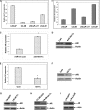MicroRNA let-7c suppresses androgen receptor expression and activity via regulation of Myc expression in prostate cancer cells
- PMID: 22128178
- PMCID: PMC3256915
- DOI: 10.1074/jbc.M111.278705
MicroRNA let-7c suppresses androgen receptor expression and activity via regulation of Myc expression in prostate cancer cells
Abstract
Castration-resistant prostate cancer continues to rely on androgen receptor (AR) expression. AR plays a central role in the development of prostate cancer and progression to castration resistance during and after androgen deprivation therapy. Here, we identified miR-let-7c as a key regulator of expression of AR. miR-let-7c suppresses AR expression and activity in human prostate cancer cells by targeting its transcription via c-Myc. Suppression of AR by let-7c leads to decreased cell proliferation of human prostate cancer cells. Down-regulation of Let-7c in prostate cancer specimens is inversely correlated with AR expression, whereas the expression of Lin28 (a repressor of let-7) is correlated positively with AR expression. Our study demonstrates that the miRNA let-7c plays an important role in the regulation of androgen signaling in prostate cancer by down-regulating AR expression. These results suggest that reconstitution of miR-let-7c may aid in targeting enhanced and hypersensitive AR in advanced prostate cancer.
Figures







References
-
- Lamont K. R., Tindall D. J. (2010) Androgen regulation of gene expression. Adv. Cancer Res. 107, 137–162 - PubMed
-
- Coppola V., de Maria R., Bonci D. (2010) Endocr. Relat. Cancer 17, F1–F17 - PubMed
-
- Shi X. B., Tepper C. G., deVere White R. W. (2008) Cancerous miRNAs and their regulation. Cell Cycle 7, 1529–1538 - PubMed
-
- Gandellini P., Folini M., Zaffaroni N. (2009) Towards the definition of prostate cancer-related microRNAs. Where are we now? Trends Mol. Med. 15, 381–390 - PubMed
Publication types
MeSH terms
Substances
Grants and funding
LinkOut - more resources
Full Text Sources
Medical
Research Materials

